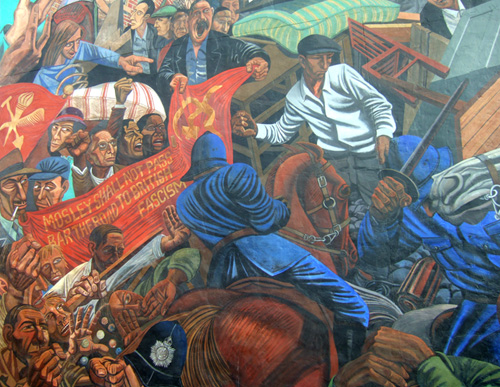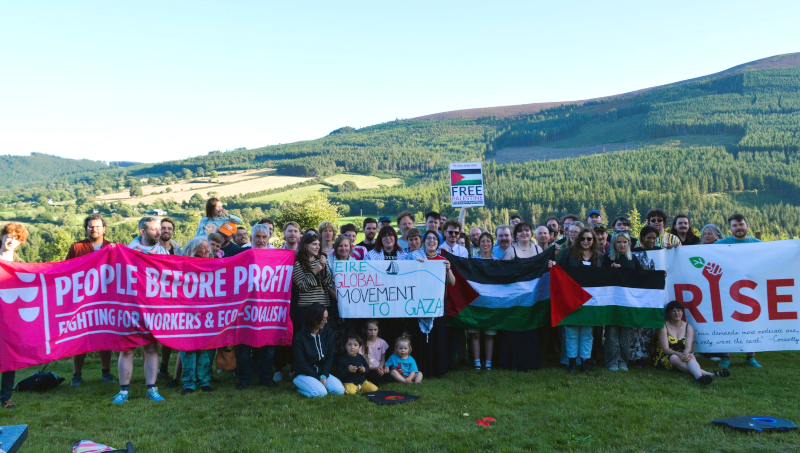“The present situation of the Jews, apparently triumphant in Israel and at the apogee of their prestige in the capitalist world, is more tragic under this glory than it often was under humiliation.”
— Maxime Rodinson, 1968.[1]
This month marks 70 years since the Jewish uprising at Warsaw. By early 1943, Europe’s main Jewish population centre – concentrated by Nazi decree in 1940 into a ghetto whose inhabitants soon numbered more than half a million – had in successive waves of liquidation been reduced to well under one hundred thousand (about 35,000 registered with the Nazis, but possibly double that number in total). Many had been starved to death, many gunned down, most deported in July-September 1942 for extermination at Treblinka. On the morning of April 19 1943, an SS-led force deployed against the Warsaw Ghetto with orders to complete its liquidation in an operation projected to last three days. Its captive population, finally mobilized into coordinated resistance organizations, met the SS with intense, lightly armed resistance and dealt the Nazis a series of limited defeats; several weeks of determined rebellion ensued. “At the end of June,” writes Hannah Arendt, “the underground newspapers were still reporting guerrilla skirmishes in the ghetto streets.”[2]

The Warsaw Ghetto revolt has a rightfully iconic place in the long history of underarmed popular resistance to state violence. But it is difficult to commemorate without bitterness. First, because the successes of those captive Jews who resolved to at least die with molotov cocktails in hand were won against a backdrop of such catastrophic defeat. And second, because this broader defeat continues to reverberate in the most politically degrading ways. It is, for example, a particularly bitter truth that the very political culture that sustains much contemporary Western state violence has appropriated a (twisted) politics of venerated Jewish militancy.
In today’s circumstances it is impossible to discuss this mess without first emphasizing that it is, of course, most dramatically on display in Palestine. Without diminishing this in the least, this article focuses on its broader context. It first reviews the connection between wartime catastrophe in Europe and the deterioration of organized Jewish politics, and then discusses the twisted place of this history within the general politics of racism in the West.
Aspects of the Defeat
Before their mass extermination, recalls Yitzhak Laor, Europe’s Jews were “never accepted as full members of the West, despite the fashionable nostalgia for these dead Jews today.”[3] Yet use of their memory as a means of dignifying contemporary Western racism has become an irony as obvious as it is harsh. The theme plays out across Western political culture, and Laor rightly notes that “the Jews or Israel are bit players in that particular drama.”[4] Bit players, though, are still players. How did a politics of Jewish militancy, of all things, get put to the service of oppressive state power?
Within organized Jewish politics, the glorification of nationalist statehood was relatively limited prior to the Nazi holocaust. The struggle against fascism has been usefully described as less a clash between states than an “international ideological civil war,” and in this war, the Jewish far right faced an uphill battle.[5] Would-be-fascists within the Jewish scene were severely weakened, among other things, by the glaring anti-Semitism of their political counterparts in other communities. Through the West, fascism made real inroads: in Britain, Mosley’s Union of Fascists wasn’t decisively beaten back until relatively late in the 1930s; in the United States, no less a figure than John Foster Dulles reflected an outspoken rejection of militant anti-fascism: it was only by lazy political habit that “Hitler, Mussolini and Japanese war lords in turn become the object of our suspicion,” Dulles reasoned in a 1935 article for Atlantic Monthly: “They too want peace but they undoubtedly feel within themselves potentialities which are repressed and desire to keep open avenues of change.”[6] Among Jews, fascist-friendly argumentation made for a tough sell.
A few tried. The right wing of the Zionist movement, the “Revisionists” organized around Ze’ev (Vladimir) Jabotinsky, had to work through the 1930s to shake their perceived association with fascism. The Revisionists were the only section of the Zionist movement openly advocating Jewish statehood at the time, and they became something of a centre of gravity for jingoism. When Jabotinsky visited Palestine at the beginning of the 1930s, the far right Revisionist Aba Achimeir appealed to him to assume the title “Duce” out of respect for the Italian model. Predictably, the outspoken support for European fascism expressed by Achimeir’s faction quickly became a liability. In 1933, Jabotinsky sharply rebuked the faction for its embarrassing literature: “To find in Hitlerism some feature of a ‘national liberation movement’ is sheer ignorance. Moreover, and under present circumstances, all this babbling is discrediting and paralyzing my work.”[7]
For the Revisionists, some more embarrassing babble soon came from a more prominent source. In 1935, Mussolini went on record with the following advice: “For Zionism to succeed, you need to have a Jewish State with a Jewish flag and a Jewish language. The person who really understands that is your fascist, Jabotinsky.”[8] Such points of perceived association, compounded by the convergence between European anti-Semitism’s drive to eject the Jews from Europe and Zionist efforts toward mass European emigration, for some time earned the Revisionists much (justifiably) sharp criticism. Indeed in 1948, to cite a particularly famous example, Albert Einstein and a number of other leading public personalities co-signed a letter to the New York Times condemning the forces under Jabotinsky’s principal political heir, Menachem Begin, as the “latest manifestation of fascism.”[9]
But back to pre-war Europe. While many leftist Jews were of course not associated with “Jewish politics” as such, preferring to join general parties as individual militants, even in the Jewish nationalist camp the balance tended to favour the left. In pre-holocaust Poland, for example, which was Europe’s main Jewish centre, the leading Jewish party was the General Jewish Labour Bund. In 1936, the Bund participated in elections for Poland’s recognized Jewish communal structure, the Kehilla, and won a plurality of votes (Polish authorities soon disbanded the Kehilla). In city-wide legislative elections across the country in 1938, the Bund gained an absolute majority of Jewish votes and thereafter formed the principal Jewish presence in the Polish legislature.[10] Not until the 1940s was the political balance in Jewish nationalist circles truly transformed.
There are various reasons that the anti-Zionist nationalism developed by sections of the left did not survive the war as a real social force. The main one, to state the painfully obvious, was that its programs concerned the organization and future of a population that was mostly dead, and whose remnant was poorly positioned to contend with enduring hostility in countries like Poland. Perhaps inevitably, the centre of gravity within Jewish nationalist politics swung to the Zionist option.
The “Revisionist Landslide”
Fatefully, the swing to the Zionist option coincided with what Hannah Arendt described at the time as a “Revisionist landslide in the Zionist organization.”[11] Arendt was an invested observer and consistent commentator on organized Jewish politics throughout this period, herself clearly committed to a sort of Jewish nationalism, indeed to a sort of Zionism. Her wartime writing combined desperate calls for armed action against the enemy in Europe with distress at the course of organized Zionist politics: the embrace of imperial alliances (“protection by these interests supports a people as the rope supports for hanging”), the sudden unanimity of Zionist calls for a Jewish state (“the very discussion of which was still taboo during the 1930s”), the channeling of Jewish militancy toward these “chauvinist claims – not against the foes of the Jewish people but against its possible friends and present neighbours.”[12] Seven decades on one won’t agree with everything she writes, but her analysis remains quite valuable.
Arendt’s observations are particularly useful as a corrective to longstanding misrepresentation in the West of the rightist Labour Zionism developed by David Ben-Gurion, the predominant force in the establishment of the Israeli state. In post-war contexts where the organized left has had influence, these politics have often been packaged and sold as vaguely socialist. The standard biography written by Michael Bar Zohar, for example, was first presented to the West (initially in France) with the title Ben-Gurion: Armed Prophet (1966), a heavy-handed grab from the first installment of Isaac Deutscher’s work on Trotsky, The Prophet Armed (1954). It is, however, with a fatal dose of understatement that the book offers the following disclaimer: “his socialist ideas became increasingly elastic in order to serve the nationalist movement.”[13] The implications of their “elasticity” is more bluntly described by Arendt (1944): “under the leadership of Ben-Gurion, whose Revisionist leanings were still violently denounced by Palestine labour in 1935, the Zionist Organization has adopted the Revisionist Jewish state program.”[14]
The implications for Palestinian Arabs are a matter of record. The question was obvious: If Palestine was to become a Jewish state, what about the Arab majority living there? Writing in December 1943, Arendt seemed certain about one thing: “the slogan of ‘population transfers’ (as suggested by Revisionists) . . . will never work without fascist organizations.”[15] But as the months dragged on, wartime developments threw momentum behind Ben-Gurion’s leadership. And as Ben-Gurion cemented a statist base in both Palestine and the United States, Arendt was forced to admit that “the Revisionist principle, if not yet the Revisionist methods, has won a decisive victory.”[16] In 1948, the “Revisionist methods” (namely, forcible “transfer” of Palestinians from their lands) followed.
It’s no doubt true, as Arendt observed, that from the very beginning “Zionist ideology, in the Herzlian version, had a definite tendency toward what was later known as Revisionist attitudes, and could escape from them only through a willful blindness to the real political issues that were at stake.”[17] But the increasing breadth of organized Jewish support for a leadership in Palestine openly espousing these attitudes was largely driven by the catastrophe in Europe. This reflected a degeneration of Jewish nationalist politics that has gained pace since.
The French (Jewish) leftist Maxime Rodinson provided some of the sharpest early commentary on “this immense mess.” Rodinson, perhaps the leading left critic of Israel in the early post-war West, was no Jewish nationalist himself; his parents had been sent to Auschwitz not as practicing Jews but as ethnically Jewish communists, and Rodinson fit a similar political mould. But while suspicious of nationalism, Rodinson emphasized that the problem here was much more fundamental. He wrote:
“In the abstract, an ingathering of Jews having retained some ethnic or quasi-ethnic specificity into a community of a national type in the broadest sense could have conceivable – quite apart from the faithful of the Jewish religion, for whom affiliation to a religious-type formation is a right. But the Zionist option brought about this ingathering under the worse possible conditions. Its consequences led almost inevitably to placing it in a reactionary context.”[18]
Detailed discussion of how this has played out in the decades since is for another place. But whether “inevitably” or not, the trajectory has been as reactionary as could be imagined. The results should now be visible to all, and a short sample from contemporary Israeli politics may suffice. In 2011 Ari Shavit, an editorial board member with the liberal Israeli daily Ha’aretz, wrote a series of articles expressing dismay at the Jewish Israeli political surge to the right. Shavit represents the politics of what many would call Israel’s “centre left,” an element steadily losing ground to the far right. After arguing that not only the smaller fundamentalist parties but also Binyamin Netanyahu’s Likud have moved much too far to the right, Shavit provides this extremely significant piece of advice: “The time has come for him to return to the values of Herzl, Jabotinsky and Begin.”[19]
In short, the Revisionists have their state. And its political centre, losing ground to the far right, looks in defense back to the liberalism of Jabotinsky (Achimeir’s proposed “Duce”) and Begin (Einstein’s “fascist”). It’s hard to imagine a grislier outcome to last century’s struggles.
Anti-Semitism and Colonial Violence
Such reactionary forces require unflinching opposition. But the indefensible narrowness of Western holocaust memorialization can’t be pinned on the Jewish right. This, as Yitzhak Laor and others have carefully explored, is deployed by the liberal West on a much wider stage – as if, through focused condemnation of the Nazis, the broader racist context from which they emerged can be insulated from their stigma.
And twisted as it is, “for the majority of the West’s contemporary political leaders and opinion makers,” again in Laor’s words,
“this is where the Jewish genocide plays its part. The Holocaust alone can provide the definition of evil. The great advantage of this is that the Holocaust took place in the past and is now over; we can congratulate ourselves on having awoken from a nightmare. But the other evils are still lurking there.”[20]
On the anniversary of the Warsaw uprising as ever, there is good reason to single out the Nazis. In a century of much racist mass killing, their atrocities were among the worst. Aspects of their industrialized exterminism (of Roma, in particular, as well as Jews) were indeed somewhat unique. Too much is often made of the differences, but some are there. Concerning death through slave labour, and sticking with crimes involving fatality counts in the millions, perhaps it is true that the death of Congolese slave labourers under Belgian colonialism was considered means to other formal ends (theft of resources, etc.) by the culprits, whereas Nazi decision-makers often considered deaths through slave labour an end in themselves.[21] Turning to the record of the paramount post-war power, the fewer millions, but millions nonetheless, killed during the United States assault on Indochina included among them many whose bodies were burned by napalm designed to purpose by “those backroom boys at Dow.”[22] But yes, whereas even enthusiastic collaboration by those targeted for extermination by the Nazis could not spare them death, United States aerial massacres did not count wholesale elimination among their primary objectives so much as ruthlessly enforced capitulation. Regardless, the lesson of Nazi brutality surely can’t be that racist state violence only merits horror when it takes the form of fully exterminist crematoria.
One would hope that the lesson would involve some sort of consistent anti-racism; that just as the development of anti-Semitism had been connected to and paralleled by colonial racism, they would be opposed together and in the same spirit. But while the anti-Nazi fight did force a backlash to some of the most explicit kinds of racist thought, the break was hardly clean. And in some quarters, it seemed enough to adjust the terms of racism: humanity rightly divides between the civilized and those against whom racism is warranted, some suggested (if not always explicitly), but Jews ought to be placed on the privileged side of the split.
Consider the words of James McDonald, the first United States ambassador to Israel. In his book recounting his diplomatic experiences (published in 1951), he provides the following, extremely revealing description of a Zionist youth gathering to which he’d been invited:
“Had I not known where I was, or heard the Hebrew words, I would have sworn that most of [the children] were of Irish, Scandinavian or Scotch stock, or at any rate of the ordinary mixture of the American Middle West. Only here and there was there a face even remotely resembling the ‘Jewish type’ of caricature. I am not an authority on the biology of races, but it was clear enough that this generation of Israel’s young Jews had no distinctive ‘racial attributes.’”[23]
The implications for the majority of humanity, those with McDonald’s “racial attributes,” are plain. But simply concerning Jews, it takes impressive WASP chutzpah to write such satisfied filth so soon after mass killings in which those without identifiably Jewish features had an observed advantage in escaping detection and extermination. Anyway, President Truman had earlier expressed concern that the State Department’s approach to the Middle East was “anti-Semitic”: “they put the Jews in the same category as Chinamen and Negroes,” complained the President.[24] Evidently, his selected diplomatic representative didn’t make the same mistake.
Unlikely Imperial Alibis
Among post-war Western liberals, a politics of dehumanization based on open talk of “the biology of races” soon went out of fashion. But its fundamental character endured. And so too did a certain liberal satisfaction with a backlash to anti-Semitism that left racism against others effectively intact.
The connection between this narrow backlash and structural racism – linking up, in turn, with Western military intervention and large-scale killing – has been most visible in the development of anti-Arab racism. The theme was apparent from early on in France. Some of the country’s worst post-war atrocities were committed in its war to maintain colonial rule in Algeria, “a particularly brutal campaign” which “popularized the subsequently widespread and infamous use of torture by electric shocks applied to tongues, nipples and genitalia” (later used so widely under U.S. direction in Latin America).[25] In the effort to maintain political support for the campaign, wrote Rodinson, alliance with Israel was used not only for military purposes but also to sooth
“the liberal and Left-wing conscience. Support for a state widely accepted as socialist, support for the Jews whom Hitlerite persecution had turned into the living symbol of the minority oppressed by Fascism, all this lent the anti-Algerian faction a spurious but effective aura of militant anti-Fascism.”[26]
A similar theme took hold in the United States (and closely allied states) in the late decades of the twentieth century. In his defense of the Indochina wars, Why We Were in Vietnam (1982), Norman Podhoretz derides the place of the Nazi record in the thinking of people who recoil from state violence; among the misguided, “Vietnam did not so much reverse the legacy of Munich as it succeeded to the legacy of Auschwitz.”[27] Since, much intellectual effort has been expended in order to re-frame the “legacy of Auschwitz” itself.
“Responsible anti-racism, we learn, expresses itself not through popular resistance but through Allied air strikes, troop deployments and proxy war.”
Immediately after the Second World War, Allied leaders had done their best to exploit memories of Munich. The primary lesson of the war, they insisted, was that Western states and public opinion must always be ready for war, that to back down in the face of any foreign adversary is “appeasement.” In more recent decades, as the U.S.-led drive to dominate the Middle East has come to define international politics, the smearing of Third World enemies as “anti-Semites” has picked up on this theme. Responsible anti-racism, we learn, expresses itself not through popular resistance but through Allied air strikes, troop deployments and proxy war.
Conclusion
There is every reason to remember and honour self-organized resistance to the Nazis, even seven decades on. It is perhaps reasonable to feel some unease that, in a culture still so pervaded by racism and the whitewashing of state crimes, Hollywood audiences wishing to do so need look no further than the James Bond of our decade (literally; in the 2008 blockbuster Defiance, we see none other than Daniel Craig leading one of the better known Jewish partisan groups).[28] Blockbuster dramatization of battles at Dien Bien Phu or Fallujah is rather less likely – though in fairness, Danny Glover is working on Haiti (but “where are the white heroes?,” Glover quotes reluctant funders as saying as they turned him down). Regardless, any celebration of militant resistance to state violence expresses important and healthy sentiments.
Its abuse in the service of power, on the other hand, deserves the sharpest hostility and contempt. This past weekend, like clockwork, Netanyahu took a break from orchestrating ongoing war crimes against Palestinians to exploit the “legacy of Auschwitz” from the Yad Vashem Holocaust memorial museum (Sunday April 7). Speaking from the museum’s Warsaw Ghetto Square, he repeated the familiar diplomatic theme: “The murderous hatred against the Jews has not passed from the world, but it simply was replaced by murderous hatred against the Jewish state.” In remarks at Auschwitz the same day, Israel Defense Forces (IDF) chief of staff Benny Gantz hammered away at the same theme: “The State of Israel is the assurance that such an atrocity doesn’t repeat itself, and the IDF is the shield that protects the national home, a safe haven for the entire Jewish people.”[29]
From both diplomatic sources and much Israeli and Western scholarship, demands for such flag-waving memorialization abound. Any criticism of Israel risks defamation in line with the above theme, and fully principled criticism almost guarantees it. As Joseph Massad has written, “Palestinian history, to the extent that it forced itself on Zionism,” is presented “as a continuation of European anti-Semitism.”[30] And the same goes for any opposition to erasure of this history. In particular, responsible intellectuals tell us that to consistently oppose the program of “population transfer” – maybe the most reactionary answer to inter-community relations short of physical annihilation – is effectively racist. It took population transfer for Israel to achieve a Jewish majority, and a Jewish majority state is the only just answer to Nazi crimes; thus the indigenous Palestinian presence was, and is, an anti-Semitic threat by virtue of its very existence.
On this anniversary of the Warsaw uprising, the anti-fascist resistance of decades gone by deserves to be honoured. But the Israeli leadership, and those who fail to oppose them, have forfeited their place in decent commemorations. The question of what tactical alliances may be appropriate to isolate and defeat the enduring (if relatively marginal) threat of anti-Semitic white supremacy deserves careful consideration.[31] But in the final count, the lessons of this history need to translate into an unflinching and much broader anti-racism.
Today this will bring leftists into open conflict with those invoking a hollowed politics of resistance in the name of state policy. This is tragic but unavoidable. Where this immense mess causes unnecessary hesitation on important questions of principle, it only adds further insult to injury. •





